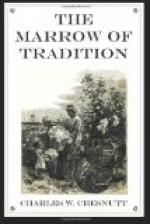Old Mammy Jane, however, was not entirely at ease concerning the child. She had discovered, under its left ear, a small mole, which led her to fear that the child was born for bad luck. Had the baby been black, or yellow, or poor-white, Jane would unhesitatingly have named, as his ultimate fate, a not uncommon form of taking off, usually resultant upon the infraction of certain laws, or, in these swift modern days, upon too violent a departure from established social customs. It was manifestly impossible that a child of such high quality as the grandson of her old mistress should die by judicial strangulation; but nevertheless the warning was a serious thing, and not to be lightly disregarded.
Not wishing to be considered as a prophet of evil omen, Jane kept her own counsel in regard to this significant discovery. But later, after the child was several days old, she filled a small vial with water in which the infant had been washed, and took it to a certain wise old black woman, who lived on the farther edge of the town and was well known to be versed in witchcraft and conjuration. The conjure woman added to the contents of the bottle a bit of calamus root, and one of the cervical vertebrae from the skeleton of a black cat, with several other mysterious ingredients, the nature of which she did not disclose. Following instructions given her, Aunt Jane buried the bottle in Carteret’s back yard, one night during the full moon, as a good-luck charm to ward off evil from the little grandson of her dear mistress, so long since dead and gone to heaven.
II
THE CHRISTENING PARTY
They named the Carteret baby Theodore Felix. Theodore was a family name, and had been borne by the eldest son for several generations, the major himself being a second son. Having thus given the child two beautiful names, replete with religious and sentimental significance, they called him—“Dodie.”
The baby was christened some six weeks after its birth, by which time Mrs. Carteret was able to be out. Old Mammy Jane, who had been brought up in the church, but who, like some better informed people in all ages, found religion not inconsistent with a strong vein of superstition, felt her fears for the baby’s future much relieved when the rector had made the sign of the cross and sprinkled little Dodie with the water from the carved marble font, which had come from England in the reign of King Charles the Martyr, as the ill-fated son of James I. was known to St. Andrew’s. Upon this special occasion Mammy Jane had been provided with a seat downstairs among the white people, to her own intense satisfaction, and to the secret envy of a small colored attendance in the gallery, to whom she was ostentatiously pointed out by her grandson Jerry, porter at the Morning Chronicle office, who sat among them in the front row.




